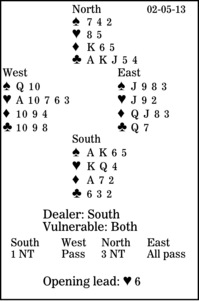Bridge column, February 5: The way to play a suit can vary

Victor Hugo wrote, "He who every morning plans the transactions of the day, and follows that plan, carries a thread that will guide him through a labyrinth of the most busy life."
A declarer who every first trick plans the transactions of the deal, and follows that plan, carries a thread that will guide him through a labyrinth of a most busy deal.
That is true, but declarers must always be ready to change their plans if necessary. For example, look at today's club suit. If South has no other worries, what is his best play for four tricks? Then, South is in three no-trump. West leads the heart six: five, jack, king. How should declarer plan the transactions of the deal?
South has seven top tricks: two spades, one heart (trick one), two diamonds and two clubs. He needs two -- not three -- more club tricks to get home.
In isolation, the best plan is to cash dummy's ace, then play low to dummy's jack on the second round. But one of the main reasons bridge retains its popularity is that the right way to play a suit mathematically will not always be the correct approach in a given deal.
Here, if East gets on play, he will lead a heart through South's queen. That will not hurt if the hearts are 4-4, but if they are 5-3 or 6-2, the contract will fail. Declarer must work to keep East off play. South should lead a club to the king and cash the ace. Here, the queen drops and South gains an overtrick. But if the queen has not appeared (and the suit is 3-2), declarer plays a third round, hoping for the best.
** ** **
COPYRIGHT: 2013, UNITED FEATURE SYNDICATE
DISTRIBUTED BY UNIVERSAL UCLICK FOR UFS

